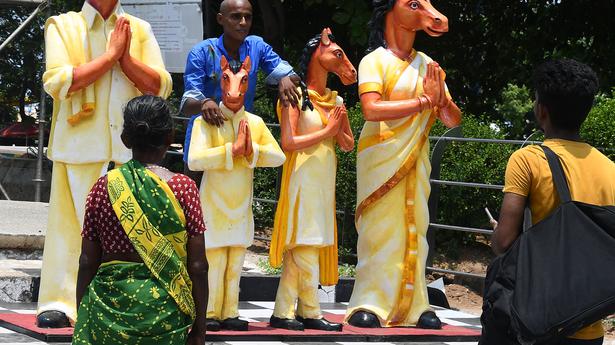
The rise and rise of chess players
The Hindu
Young stars can now afford to dream of making it big in chess, which was not the case earlier
‘Thambi’, the mascot of the 44th Chess Olympiad, greeted me soon after I landed at the Chennai airport. Wearing his white dhoti and shirt, he welcomed every passenger with folded hands from the blue hoarding. I encountered him several times during the smooth drive to Mamallapuram, the scenic venue of the Olympiad. The world’s most prestigious team event for chess, featuring over 1,700 players from 186 countries, has created a huge buzz. It is getting the attention it deserves from the public and the media in India. This may be the largest chess event for India, but there have been some big ones before, such as the World Championships of 2000 and 2013. However, those events did not quite capture the public’s imagination like the way the Olympiad has.
Viswanathan Anand was the common feature at both those events. I remember the frenzy he created at Delhi’s Hyatt Regency more than two decades ago. I saw how much he meant to the Indian chess fans. It was my second meeting with him. The first time I met him, I wasn’t a journalist. I was one of the players at the Kerala State Junior Chess Championship at Pala. He had come for a felicitation after winning the World Junior Championship in 1987; it was a turning point for his career and for Indian chess.
When Anand played Magnus Carlsen at home, 13 years after his first title, the media interest in chess had grown considerably. I remember chatting, at Chennai’s Hyatt Regency, with members of a particularly large contingent from Norway, who did not want to miss the possible crowning of their first world champion. Carlsen did not disappoint them. Now, he is back in Chennai and is among the biggest attractions at the Olympiad. He arrived shortly after abdicating his world title, which he won five times in a row, citing lack of motivation.
The interest in chess in India has grown even more since Carlsen’s last visit. The live streaming of chess tournaments, the rapid strides the game made during the pandemic (it is suited for the virtual world), the fact that India jointly won the Online Chess Olympiad along with Russia, the popularity of the Netflix series The Queen’s Gambit, which took the game to the mainstream, and the emergence of a fabulous bunch of teenagers who are ready to take on the world are all contributing factors to this phenomenon. That Anand is mentoring the youngsters augurs well for Indian chess. Young stars like R. Praggnanandhaa, Arjun Erigaisi, Nihal Sarin, D. Gukesh and Raunak Sadhwani can now afford to dream of making it really big in chess, which was not the case earlier.
An anecdote illustrates this well. In the early days of his career, when Anand was travelling by train, a fellow passenger started a conversation with him. “What do you do,” he asked Anand. “I play chess,” Anand said. The passenger persisted, “But what do you do for a living?” Anand again replied, “I play chess.” The man said: “Who do you think you are? Viswanathan Anand?”
Another Indian star, from around that time, also had to answer a difficult question when he was introduced to someone as a chess player. “Singles or doubles?” the person wanted to know. A chess star today may not have to go through experiences like these.
India’s knowledge of chess has come a long way since then. People know that possibilities are enormous for a talented child. That is why parents are taking their children to chess classes and making enormous sacrifices. For instance, during a tournament many years ago, I met a soft-spoken man who told me that he had quit his job as a lecturer so that he could concentrate on his daughter’s career in chess. Today, she is the strongest female player at the Chennai Chess Olympiad. And you guessed it right: that’s Koneru Humpy.











